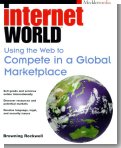
| Columns | Discoveries | Updates | Ideas | FAQ | Tools | Books | PR | Communication Circle |
Books |
Using the Web to Compete in a Global Marketplace |
| |
 Browning
Rockwell Browning
RockwellWiley $29.99 0-471-25262-X 314 pages October, 1998
As more and more stores find their percentages of international sales doubling and tripling, every store on the Web needs to think about building a global business, and this book shows how to make your store inviting to visitors from other countries, guard against common problems, and sidestep the potential hazards of unfamiliar customs requirements, standards, and laws. "Before the Internet and the liberalization of global trade, international trade was expensive, complex, time consuming, and largely for big players only. Today, cross-border commerce is low cost, simple, instant, and accessible to virtually any business, no matter how small." The book shows how going global on the Web forces a business to rethink its business model, reinvent business processes, change the corporate culture, and do an even better job of handling relationships with suppliers and customers. Key ideas:
To buy this book at a discount, or find out more about it, please visit Amazon.com's electronic bookstore. We are proud to be an Amazon.com Associate. |
The Best of Online Shopping: : Columns/Discoveries/Updates/Ideas/FAQ/Tools/Books/PR
Communication Circle: Services/Tips/Theory/WebPoems/Workshops/Books/Articles/Lisa/Jonathan
Copyright 1999 Jonathan and Lisa Price, The Communication Circle
Please return to our site at http://www.theprices.com
Email us at ThePrices@swcp.com